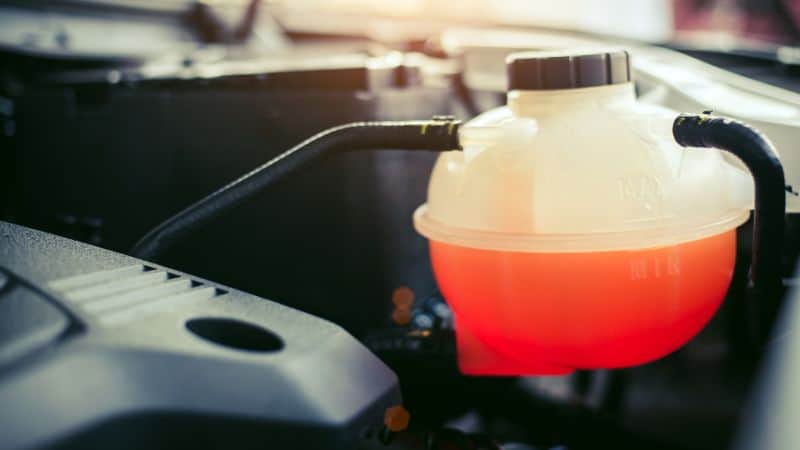You towing a trailer or running an air conditioner means your engine works harder. That’s why you need to cool down your engine more. Having an effective cooling system can develop your engine’s reliability. If you want to keep it in proper working order, you can do a few simple checks.
But how to check your car cooling system? This question is very trendy. And it’s essential to keep your vehicle’s routine maintenance, which includes regular coolant changes. However, let’s learn how to check the car cooling system below.

How To Check Coolant Level?
Checking the coolant level in your vehicle is a relatively straightforward process. But remember, you should check the coolant level when the car is cold. See the step-by-step process below:
Step 1. Make Sure Your Engine is Cool.
Generally, don’t check your coolant level if the engine is not cold. Most car cooling systems work under pressure and at temperatures above the water boiling point.
Likewise, you check the coolant while your car is warm, and a boiling liquid gas will come out. As a result, extreme burns will occur. After your last drive, please let your car sit for a few hours to keep your engine cool. Moreover, you can idle your car overnight.
Step 2: Find Out The Radiator Cap
Open the hood of your car and discover the radiator cap. Basically, after opening it, you should find the radiator, which is under the hood. With the hood open, look at the front of the motor bay to discover the radiator.
There will almost always be a radiator cap above the radiator. Some vehicles come with a front-mounted radiator. And read your manufacturer’s books to know the cap’s location.
Step 3: Open the Radiator Cap
Open the radiator cap after locating the cap and ensuring the vehicle is cold. Place this cap in a secure site so that it is lost. Be careful so that anything can’t drop into the cooling system.
Step 4. Discover The Fluid
A car’s cooling system is entirely of coolant or water, so you can see it when you open the twist. Usually, the liquid color will be orange, green, or another vibrant color. Typically, if you live in a sweltering climate, it can be regular water. Thus, if you don’t see coolant, keep the light on to visit the fluid shimmer.
There is a fluid, which means your car has enough coolant. Unfortunately, if you can’t see liquid, add some needed coolant. At last, secure the radiator cap down tightly, and done! You have checked your car’s coolant level properly.
Why Should I Check My Car’s Coolant?
Sometimes, coolant is not checked frequently for an extended period. Though mechanics change the oil annually as part of a service, they don’t check the coolant regularly. Additionally, a premium coolant like Prestone will last up to 10 years.
So it can save you time and money over a long period. Alternatively, if you aren’t sure properly when you last changed your coolant check your coolant. Also, checking is a good idea if you recently bought a used car and don’t know about the coolant level.
Notably, using the same coolant for a long time can’t protect your vehicle from extreme corrosion and temperature. Furthermore, if you don’t replace it in time, your engine is at risk of tearing and freezing. For that, you can need costly repairs because of engine damage.
How to Check Your Car Cooling System?
Let’s learn how to check the coolant system and what to find when you’re under the hood.
- Be Sure the Engine is Cool
When your engine is cold, you should check the coolant. Opening the coolant system when the engine is hot can be dangerous. Use a damp cloth if you cannot wait too long for the engine to cool down.
- Discover the Coolant Reservoir
Adequately, the coolant reservoir looks like a container found near the radiator. Usually, you can notice it on the front of the engine.
- Inspect the Coolant Level
Knowing the current coolant level would help if you understood the coolant reservoir side mark. There are usually “minimum” and “maximum” marks. You can learn the bad and good sides of the coolant with these two marks. In addition, if you can see your coolant level is below the minimum mark, you should add some more coolant.
- Check The Color of Coolant
Depending on the brand and type, coolant comes in different colors, like orange, green, yellow, or blue. The coolant color is consistent and vibrant, so your coolant is in good condition. Discolored coolant, or if it contains gliding particles, indicates your coolant is contaminated.
- Observe The Coolant Clarity
Coolant must be clean and free of residue or deposits. Unluckily, if you see any floating particles or a cloudy appearance, this indicates you to flush or replace the coolant.
- Check For Signs of Oil Pollution
Accordingly, if the coolant appears milky or has an oily sheen on its surface, this may indicate a coolant leak. Or it can cause more severe problems, like head gasket failure. Hence, you should immediately identify any oil pollution in the coolant by an experienced mechanic.
- Check For Coolant Leaks
Examine the coolant reservoir and the surrounding areas for any signs of coolant leaks, such as wet spots, stains, or a strong odor. As you know, leaks can cause severe coolant loss and overheating.
The Cooling System Pressure Test Procedure
Adversely, if you want to open the cooling system and put it back, you may pressurize the cooling system. Nevertheless, the cooling system pressure test procedure is as follows:
Component that you will need:
- A cooling system pressure tester kit
- Water
- A pan to catch the coolant
Now, let’s know the coolant pressure test technique below:
Step 1. Check the upper radiator hose
Step 2. Remove the radiator cap
Step 3. Connect the pressure test adapter
Step 4. Connect the pressure tester
Step 5. Operate the pressure tester pump
Step 6. Disconnect the pressure tester.
How can you check your car’s cooling system for leaks without removing a hose or testing for pressure?
Car owners don’t want any problems with their cars. Engine coolant leak can be one of the crucial factors that can damage your engine. Please don’t neglect the coolant leak; otherwise, it can cause machine deterioration or crack. A pressure tester is an effective technique for inspecting a coolant leak, but it’s not always convenient. But there are many ways you can check your engine coolant leak sign. Let’s find a coolant leak without using a pressure tester.
Visual Inspection
Without a pressure tester, it can be challenging to check engine coolant leaks. Fortunately, to find coolant leak symptoms, you can visually inspect the surrounding areas of the engine. Mainly, this is a simple method; you don’t need any special equipment to perform it. Here’s how you can visually inspect your engine’s coolant leak.
- Open the hood and test the engine compartment. Find any visible coolant leak signs like puddles, spots, and steam.
- Now, check the radiator to see any damaging and cracking signs. Check the hoses for any visible holes, cracks, and wear and tear signs.
- Search any wet areas; it’s a real sign if you notice any spots.
- Then, check the water pump and discover any leak signs, like water holes or stains.
- After that, you can also examine the engine block and look for any stains around the engine base.
- At last, check the heater core, which is responsible for heating the car interior. Make sure that there are no visible leak signs.
An Alternative to Pressure Test
If you don’t have a pressure tester, you can check your coolant leak in other ways. Here are some substitute procedures for testing pressure:
- Hand Pump:
The best idea is to use a hand pump to pressurize the cooling system. Start and remove the radiator cap and connect the hand pump to the coolant overflow tank. It would help if you pumped your hand pump until it reaches the perfect pressure level. Then, examine your motor areas to discover any coolant leakage signs.
- Compressed Air:
You can use compressed air to pressure the cooling system to remove any leakage from the coolant. To do this, remove the radiator cap like others and plug the overflow valve. Once you do it, fill your coolant system with compressed air and check the gauge to see any pressure drop. Like before, techniques inspect the engine’s whole area for leaks.
- Coolant Dye Test:
Another procedure for detecting an engine coolant leak without pressure or removing a hose is using a coolant dye test. It works by adding a particular dye to the coolant system that shines under a UV flashlight. In this way, you can detect the coolant leak easily. Let’s learn the procedure of how you can test coolant dye:
- Before you begin the test, ensure that your engine is cold. Undoubtedly, put off the radiator cap and add coolant to create space for dying.
- In the radiator, just add the coolant dye and top the coolant level with water.
- After that, you should start your engine and drive it for up to 15 minutes. This procedure can ensure that dye and coolant are circulated in your system.
- Shut off the engine and use a UV flashlight to see the engine areas for leaks. Thus, if there are any leaks, they will be visible as a bright green or yellow spot.
Final Word:
On the other hand, on a regular basis, servicing a coolant is very important for your engine. The reason is that, in your cooling system, the air enters during the process. It can cause an overheating engine when the air isn’t released. That’s why, like checking your oil level, checking your car’s cooling system is essential.
Overall, how to check your car’s cooling system was the question. Ultimately, here we have tried to discuss the easy and straightforward procedure for you. We hope after reading this procedure, you can check your car’s cooling system easily and quickly.


